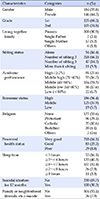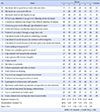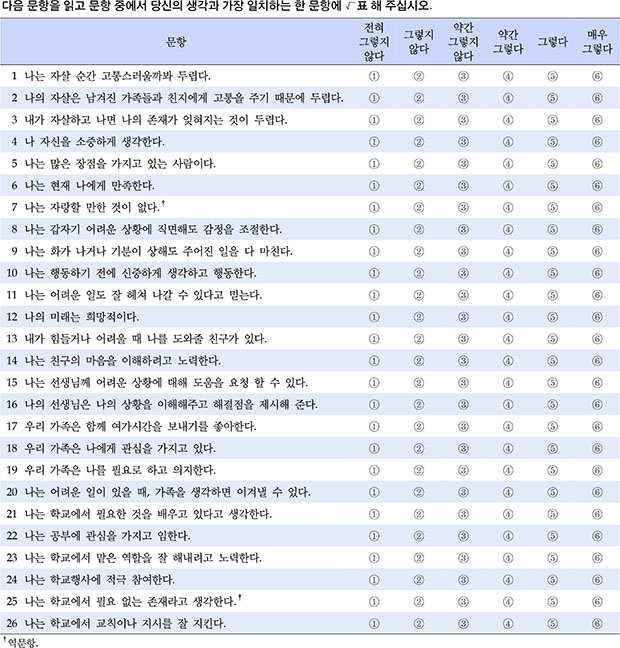Abstract
Purpose
This study was conducted to develop and test a measurement of the suicidal protection(MSP) for high school students in Korea.
Methods
Thirty-four preliminary items were initially developed based on literature review and focus group interviews. Those items were evaluated by experts for content validity with 31 items yielded. For testing validity and reliability of the measurement, data were collected from 330 high school students in Korea.
Results
The item analysis selected 26 items. One item was deleted additionally through the primary exploratory factor analysis. The final exploratory factor analysis yielded 26 items in six factors such as fear of suicide, self-esteem, emotion regulation, support from others, support from family, and school life, explaining 66.6% of the total variance of the suicidal protection for high school students in Korea. Convergent validity and discriminant validity were supported by construct reliability, average variance extracted estimate, and standardized regression weight. MSP scores were positively associated with economic status, academic record and suicidal ideation. Also, criterion validity was supported through a significant correlation with the Reason for Living Inventory for Adolescent. The Cronbach's α reliability coefficient was .93 for the overall measurement and .72~.86 for the six factors.
Figures and Tables
Table 3
Group Comparisons between MSP and Academic Performance, Economic Status, and Suicidal Ideation for 12 Month (N=330)

References
1. Ministry of Health and Welfare. 2018 Suicide prevention white book [Internet]. Seoul: Ministry of Health and Welfare;2018. cited 2018 April 16. Available from http://www.spckorea.or.kr/new/sub03/sub11_view.php?Kind=1330&Code=weblibrary&No=12516&No2=12516&Thread=A&Type=edit&page=1&Next=view&Category=국내보고서.
2. Hawton K, Saunders KEA, O'Connor RC. Self-harm and suicide in adolescents. The Lancet. 2012; 379(9834):2373–2382. DOI: 10.1016/S0140-6736(12)60322-5.

3. Borges G, Nock MK, Abad JMH, Hwang I, Sampson NA, Alonso J, et al. Twelve-month prevalence of and risk factors for suicide attempts in the World Health Organization World Mental Health Surveys. The Journal of Clinical Psychiatry. 2010; 71(12):1617–1628. DOI: 10.4088/JCP.08m04967blu.

4. Reinherz HZ, Tanner JL, Berger SR, Beardslee WR, Fitzmaurice GM. Adolescent suicidal ideation as predictive of psychopathology, suicidal behavior, and compromised functioning at age 30. American Journal of Psychiatry. 2006; 163(7):1226–1232. DOI: 10.1176/appi.ajp.163.7.1226.

5. Park JY. The effects of risk and protective factors on adolescent suicide. Korean Journal of Youth Studies. 2009; 16(10):249–272.
6. Westefeld JS, Cardin D, Deaton WL. Development of the college student reasons for living inventory. Suicide and Life-Threatening Behavior. 1992; 22(4):442–453. DOI: 10.1111/j.1943-278X.1992.tb01038.x.
7. Gutierrez PM, Osman A, Barrios FX, Kopper BA, Baker MT, Haraburda CM. Development of the reasons for living inventory for young adults. Journal of Clinical Psychology. 2002; 58(4):339–357. DOI: 10.1002/jclp.1147.

8. Linehan MM, Goodstein JL, Nielsen SL, Chiles JA. Reasons for staying alive when you are thinking of killing yourself: The reasons for living inventory. Journal of Consulting and Clinical Psychology. 1983; 51(2):276–286.

9. Osman A, Downs WR, Kopper BA, Barrios FX, Baker MT, Osman JR, et al. The reasons for living inventory for adolescents (RFLA): Development and psychometric properties. Journal of Clinical Psychology. 1998; 54(8):1063–1078. DOI: 10.1002/(SICI)1097-4679(199812)54:8<1063::AID-JCLP6>3.0.CO;2-Z.

10. Lee HJ, Shin MS, Ko HJ, Kwak YS. A study of the reliability and validity of the korean version of the reasons for living invenory for adolescents. Journal of the Korean Academy of Child and Adolescent Psychiatry. 2014; 25(3):163–170. DOI: 10.5765/jkacap.2014.25.3.163.
11. Osman A, Gutierrez PM, Muehlenkamp JJ, Dix-Richardson F, Barrios FX, Kopper BA. Suicide resilience inventory-25: Development and preliminary psychometric properties. Psychological Reports. 2004; 94(3):1349–1360.

12. Richardson-Vejlgaard R, Sher L, Oquendo MA, Lizardi D, Stanley B. Moral objections to suicide and suicidal ideation among mood disordered Whites, Blacks, and Hispanics. Journal of Psychiatric Research. 2009; 43(4):360–365. DOI: 10.1016/j.jpsychires.2008.03.008.

13. Song JR. Suicide in korean society and durkheim's theory of suicide: In relation to ‘familistic habits of the heart.’. Journal of Korean Social Theory Association. 2008; 34:123–164.
14. Kim OS, Park EJ. A comparative study of time use differences between Korean and American high school students. Journal of Korean Home Management Association. 2012; 30(4):119–132. DOI: 10.7466/JKHMA.2012.30.4.119.

15. Park J, Chung I. The effects of high school students' academic problems on suicidal ideation-focusing on the mediational effects of individual-level risk and protective factors. Journal of the Korean Society of Child Welfare. 2010; 32:69–97.
16. De Luca SM, Wyman P, Warren K. Latino adolescent suicide ideations and attempts: Associations with connectedness to parents, peers, and teachers. Suicide and Life-Threatening Behavior. 2012; 42(6):672–683. DOI: 10.1111/j.1943-278X.2012.00121.x.
17. DeVellis RF. Scale development: theory and applications. 3rd ed. CA: Sage;2012. p. 171.
18. Colaizzi PF. Psychological research as the phenomenologist views it. In : Valle RS, King M, editors. Existential-Phenomenological Alternatives for Psychology. New-York: Oxford University Press;1978. p. 48–71.
19. Lee HS, Kim SY, Park L, Kang YJ, Lee JY, Kwon JH. The reasons of suicide-related ideation and behavior and the reasons for not choosing suicide among college students. Korean Journal of Counseling and Psychotherapy. 2012; 24(3):703–728.
20. Yeo JY, Park TY. A study of adolescent's suicidal ideation-the mediation effect of resilience and self-esteem. Korean Journal of Youth Studies. 2013; 20(8):121–145.
21. Eom TW, Kang MJ, Choi JS. Gender differences of the stress, hopelessness, depression, suicidal ideation and social support in adolescents. Journal of Human Studies. 2008; 22:5–30.
22. Cho YS, Lee KN. Effects of adolescent's alienation, depression, family environment and school maladjustment on suicidal ideation. Journal of the Korean Home Economics Association. 2010; 48(8):27–37. DOI: 10.6115/khea.2010.48.8.027.

23. Kim JG, Kim HY. A Study on adolescents' expectation of future: Focused on self-esteem and social support. Journal of the Korean Home Economics Association. 2013; 51(2):173–186. DOI: 10.6115/khea.2013.51.2.173.

24. Noh YC, Kim KS, Park HS. The test of gender difference on the causal relationships between adolescent's academic stress and suicidal thoughts. Journal of the Korea Society of Computer and Information. 2015; 20(5):133–140. DOI: 10.9708/jksci.2015.20.5.133.

25. Hong SH, No UK, Jung S. Meta-analysis about relationship between adolescents' suicidal ideation and protective factors. Survey Research. 2016; 17(1):137–166. DOI: 10.20997/SR.17.1.7.

26. Jang SY. Effects of self esteem, family support and adaptation to school life on adolescents' suicidal ideation. Journal of Korean Society for Health Education and Promotion. 2013; 30(2):11–21. DOI: 10.14367/kjhep.2013.30.2.011.
27. Kim HW, Cho SY. The moderated effect of parent-adolescent communication style and school life satisfaction on the relationship between depression and suicidal ideation among adolescents. Journal of Korean Home Management Association. 2011; 29(2):127–142.
28. Lee HJ, Kim KS, Kim KH, Nam GW, Min KW, Lee S, et al. Factors that affect the suicidal thoughts of high school students in Korea: Focusing on the socio-demographic characteristics and delinquent behaviors. Journal of the Korea Institute of Electronic Communication Sciences. 2013; 8(7):1025–1032. DOI: 10.13067/JKIECS.2013.8.7.1025.





 PDF
PDF ePub
ePub Citation
Citation Print
Print








 XML Download
XML Download